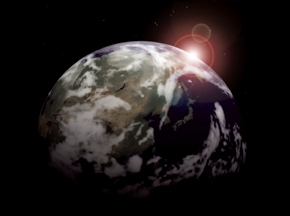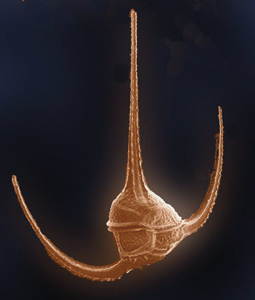Big Things From Small Packages
AMONG A PLENITUDE of work presented by EOS Ocean Process Analysis Laboratory researchers at the 2008 Ocean Sciences Meeting held in Orlando, Florida, last March was a poster about an ongoing “expeditionary learning” collaboration between OPAL’s Coastal Ocean Observing Center and the King Middle School in Portland, Maine.
The collaboration, headed up by OPAL research scientist Tim Moore and education and outreach coordinator Amy Holt Cline, provided a large group of seventh-graders with a year-long, hands-on, multidisciplinary course focused on understanding phytoplankton and their role in global climate change. In addition to a comprehensive field study component of the program, the connection between phytoplankton and ocean color satellite imagery and the Earth system at large was emphasized for students.
“Most of them had never heard of phytoplankton before. The students learned about the phytoplankton-ocean relationship and that these tiny creatures have a big impact not only on what goes on in the ocean but also the atmosphere as well,” says Moore, who just completed his doctoral work on various aspects of the little-studied phytoplankton community in the Gulf of Maine.
Since phytoplankton depend upon certain conditions for growth, they are a good indicator of change in their environment. For these reasons, and because they also exert a global-scale influence on climate, phytoplankton are of primary interest to oceanographers and Earth scientists around the world.
The King Middle School students, who also had to finalize their projects with poster presentations at year’s end, report the expeditionary learning experience helped them not only in conducting fieldwork, identifying species of phytoplankton, and interpreting satellite images, but also to “connect the marine environment to the changing climate, make changes in our own house to reduce carbon emissions, become better writers, and gain a better understanding of how scientists study the environment.”
Adds Moore, “That this microscopic world of phytoplankton is doing so much—affecting the rest of the food chain, which has global consequences—and that we can detect them from satellites and observe their change over time, that’s really quite remarkable.”
The dinoflagellate Ceratium longipies, a common phytoplankton in the Gulf of Maine. Photo: Mitchell Sogin, Marine Biological Lab . |
“Most of them had never heard of phytoplankton before. The students learned about the phytoplankton-ocean relationship and that these tiny creatures have a big impact not only on what goes on in the ocean but also the atmosphere as well,” says Moore, who just completed his doctoral work on various aspects of the little-studied phytoplankton community in the Gulf of Maine.
Since phytoplankton depend upon certain conditions for growth, they are a good indicator of change in their environment. For these reasons, and because they also exert a global-scale influence on climate, phytoplankton are of primary interest to oceanographers and Earth scientists around the world.
The King Middle School students, who also had to finalize their projects with poster presentations at year’s end, report the expeditionary learning experience helped them not only in conducting fieldwork, identifying species of phytoplankton, and interpreting satellite images, but also to “connect the marine environment to the changing climate, make changes in our own house to reduce carbon emissions, become better writers, and gain a better understanding of how scientists study the environment.”
Adds Moore, “That this microscopic world of phytoplankton is doing so much—affecting the rest of the food chain, which has global consequences—and that we can detect them from satellites and observe their change over time, that’s really quite remarkable.”
by David Sims, Science Writer, Institute for the Study of Earth, Oceans, and Space. Published in Spring 2008 issue of EOS .

